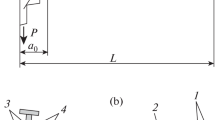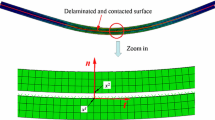Abstract
This paper concerns with a combination method of the boundary element method and the finite element method for elastic-plastic analyses. The combination method proposed here is based on the substructure method using the conjugate gradient method. This combination method has the advantage of saving CPU time and memory storage size over the finite element method. The combination method is applied to a J-integral analysis of a crack in an adhesive joint. The effect of bond thickness on the J-integral is discussed.
Similar content being viewed by others
Author information
Authors and Affiliations
Rights and permissions
About this article
Cite this article
Ikeda, T., Yamashita, A. & Miyazaki, N. Elastic-plastic analysis of crack in adhesive joint by combination of boundary element and finite element methods. Computational Mechanics 21, 533–539 (1998). https://doi.org/10.1007/s004660050331
Issue Date:
DOI: https://doi.org/10.1007/s004660050331




